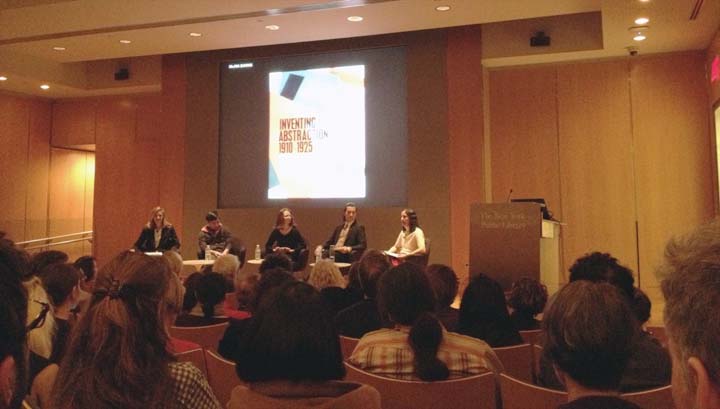The Future of Art Book Publishing
On Tuesday night, the South Court Auditorium at the New York Public Library filled up to standing room, with dozens of art book afficionados turned away. The occasion: A panel on the subject of art book publishing.
Organized by the NYPL, ARTBOOK|D.A.P. and ARLIS/NY, and moderated by Arezoo Moseni, Senior Art Librarian at the NYPL, the panel was comprised of leading figures in art book publishing: Margaret Chace, Associate Publisher, Skira-Rizzoli; Paul Chan, artist and Founder of Badlands Unlimited; Sharon Gallagher, President and Publisher of ARTBOOK|D.A.P.; and Chul R. Kim, Associate Publisher, The Museum of Modern Art.
Margaret Chace began with an overview of the current state of book publishing as it relates to the current state of bookstores in North America. One of the subjects that always crops up in a panel on publishing is the 2008-09 downturn, and the shutdown of Borders Books and branches of other megastores. Ms. Chace settled that subject for good, explaining why megastore sales do not influence art book publishing with the same impact that they do in trade publishing.
She added hopeful notes regarding the collaborations that art book publishers are forming with independent booksellers, and the news that young people, regarded as mainly digital consumers, are collecting art-books-as-objects in greater numbers. Even so, she feels that physical art books will become increasingly rarified niche items as digital publishing expands and publishers should use this trend as an opportunity to further enhance design quality and production values.

Panelists, left to right: Margaret Chace, Paul Chan, Sharon Gallagher, Chul R. Kim and Arezoo Moseni, Photo: Peggy Roalf.
Next up was Paul Chan, who gave an entertaining history of his own work as a publisher, starting with his experience following the 2008 Venice Bienale, for which he produced a major project based on the Marquis de Sade. He said, “When the project ended, I had had enough. I didn’t have any ideas worth spending time on. I stopped showing, stopped making new work and cleaned the floor of my studio—for about six months.” When he got bored of that, he decided to start a press to produce artist books. Because he didn’t have a great deal of cash on hand, and the Kindle was coming on strong, he decided to focus on eBooks.
His timing also coincided with the foment in artist book publishing and the introduction of the iPad. So Badlands Unlimited, founded in 2010, gave him the opportunity to “understand the true social nature of a book, how it gets into book store, gets bought, gets shared and passed along.” Among his upcoming titles are Marcel Duchamps: The Afternoon Interviews by Calvin Tompkins, comprised of an ebook with audio clips of interviews conducted in 1964 as well as a paperback edition.
Sharon Gallagher then took the stage, offering a wildly imaginative take on future possibilities of the art book as the increasing adoption of eBooks and web browsing overtakes sustained reading for many people. She proposed that the art book has “multiple possible futures.” And that “failure has to be an option, because how will the future of the art book be great unless we can be willing to fail in trying to realize new formats?”
In answer to her rehorital question, "Should art books have pages?" she ran through a range of possibilities, including spatial organization in architectural terms. Ms. Gallagher pointed out that art books, unlike novels, do not have narrative plots to move the reader forward. Instead, pages help readers maintain their bearings in the same way that the spatial features of a building—foyer, hallways, closed and open doors, rooms for different functions—let you know where you are.
Another feature might be a killer app that allows scholarly art books to be printed devoid of footnotes and indexes; instead there would be Q-codes directing our smartphones to online resources including “basement furniture, such as footnotes,” and more scholarly texts on the subject at hand.
Ms. Gallagher concluded her whirlwind tour of the art book of the future to note that new marketing options, such as pop-up stores in high-end retail environments like Saks Fifth Avenue and Nordstroms, are a logical reality right now. “If someone is willing to spend $5,000 for a dress, they might spend $100 on an art book,” she noted. But as publishers move forward, she urged, “Let’s treat each art book we make as if it will be our last.”
Last up was Chul R. Kim, Charles to his colleagues and friends, who presented an upbeat view of art book publishing in the digital age. Presently, MoMA's publishing arm does a roughly $5 million business annually, producing books in eight languages. The outlook for printed art books is great, he said, but advances in digital publishing will only improve; for that reason MoMA is taking an aggressive position by shaking up the hierarchy of its publishing program.
For one thing, staffers at all levels will participate in the making and marketing of eBooks in order to create a seamless exchange of ideas and experience. The first eBook on Picasso, for which the Picasso Administration will confer right, is now in the planning stage. So far, MoMA has produced 19 eBooks on various subjects, 9 on the iBookstore and 10 as fixed-format e-books through the proprietary MoMA Books app.
Mr. Kim said that the process is both challenging and frustrating. While being able to present the two Picasso guitars in the MoMA collection in a way that enables the reader to see the sculptures in 3D, rotating them to view all sides, there is a fundamental problem in reading books on an iPad: Once the device is turned off, the MoMA brand disappears and Apple takes over. This never happens when you close the cover of a MoMA book.


